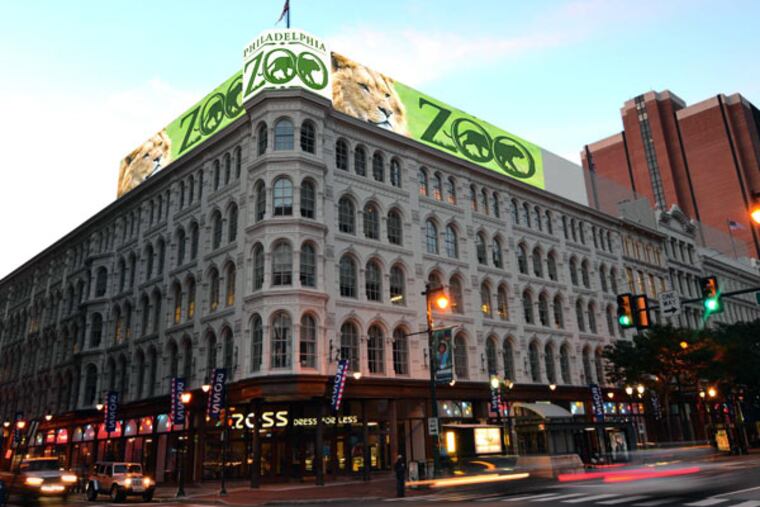Turning up the lights on gray Market St. East
In a wan corridor, Lit Bros. roof getting video screens.

The Times Square-ification of Market Street East in central Philadelphia is underway, and it is starting at one of the most treasured buildings on one of the most stubbornly seedy thoroughfares in Center City.
Construction scaffolding has begun its crawl up the cake-frosting-white facade of the former Lit Bros. department store, a century-old architectural wonder that will be home to the city's first flashy, high-tech video billboard screens.
Over the next three months, crews will work to install stadiumlike, wraparound LED signs rising 14 feet above the roofline of both corners of the landmark structure on the 700 block of Market Street.
Officials hope to light up Lits for the first time on New Year's Eve - the holiday synonymous with Times Square, the Manhattan billboard mecca whose mojo Market Street's boosters and investors are hoping to mimic.
The signs, the first of surely more to come as major redevelopment proposals firm up for Market East, will hopefully help ignite a transformation of the corridor from gray and ghostly castoff to its onetime status as a must-see slice of the big city, officials said.
"We could stream the Phillies game live," said Mark P. Merlini, the Jenkintown native in charge of operations and leasing at the building now known as Mellon Independence Center, where scaffolding began rising last week.
'Just because'
Merlini, an executive and partner at the Brickstone Cos. (which historically refurbished and reopened the Lits building in 1987 and has waited patiently for its bet on the street to pay off), rattled off the possibilities as excitedly as a kid about to get a King Kong-sized Xbox.
Imagine walking past a live Eagles game while heading toward the Liberty Bell. Or tapping a smartphone app to hear the broadcast of a breaking news story.
"We'll certainly take a shot at it," Merlini said, "just because."
The Lits billboards are going up four years after Councilman James F. Kenney joined then-colleague Frank DiCicco in sponsoring October 2010 legislation allowing for the unprecedented large-format signs to make their debut in the city.
The original idea, Kenney said, was to help property owners on Market Street East, such as Pennsylvania Real Estate Investment Trust, generate capital and spur redevelopment.
The Gallery shopping mall has long been one of PREIT's lower-performing assets, though plans are underway to refurbish it, including the impending arrival from New York of the region's first Century 21 fashion apparel store on the 800 block of Market.
Indeed, advertising contracts for billboards of this nature can be very lucrative. Merlini estimated that annual revenues from the signs to be installed atop the Lits building would be in the "seven figures."
"We didn't know what a revenue source it would be until we got into it," he said, adding that advertisement contracts were already in place.
Another motive for the legislation, Kenney said, was to breathe life into the downtrodden street, where lower rents and discount retail long ago replaced the elegance of its department-store lineage and have effectively thwarted future investment by keeping pedestrians and higher-end consumers away.
"A little upbeat fun on East Market Street can't hurt East Market Street," Kenney said. "Because it is a mess right now."
Market Street used to be a weekend playland for shoppers in the 1940s and 1950s, when lavish department stores lined the historic street. The Gallery even made a splash in the late 1970s as a groundbreaking indoor urban shopping mall.
By the early 1990s, as department stores consolidated and vanished, it became a strip of near-desolation. Today, Market East is a mishmash of undeveloped lots, low-end retail shops, and buildings repurposed into offices, including those of The Inquirer, which moved into its current location at the old Strawbridge & Clothier store at 801 Market in 2012.
The DiCicco-Kenney bill became law in June 2011, soon after which Merlini pursued his application.
One of its first stops was the Historical Commission, where it encountered some public opposition. Some people argued the signs were too unlike those that had historically hung from Lits through the years. But Merlini prevailed and the commission said yes. Then it went to city planners.
"I think it will enliven the area," said Gary Jastrzab, executive director of the City Planning Commission. "It could become a very interesting place when there are major events happening."
The signs, being manufactured in Germany, will be mounted along the edge of the roof and form a V parallel to the street at each of two corners: They will extend about 70 feet north on Seventh and on Eighth Streets, and 75 feet along the Market Street side from each corner, Merlini said.
Other upgrades
The signs will cost about $10 million. Another $10 million is being spent on public improvements, mandated by the sign law.
The highlight among these upgrades approved by city planning officials (including six renovated public bathrooms and a gussied-up Market-Frankford El subway concourse beneath the building) is a lighting system to illuminate the seemingly endless rows of arched windows that are a signature feature of the historically certified structure, which dates to the 1800s.
"Things are finally coming to fruition on East Market Street," Merlini said. ". . . I'm really excited."
215-854-2431